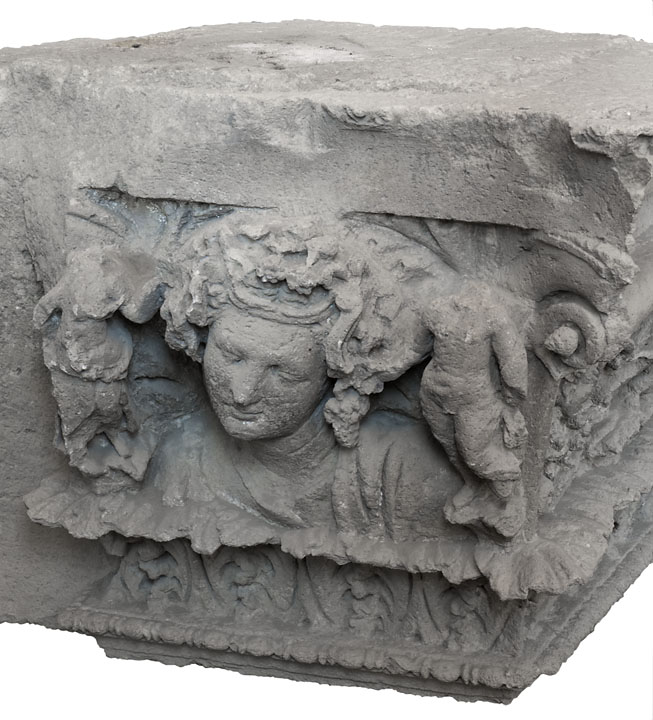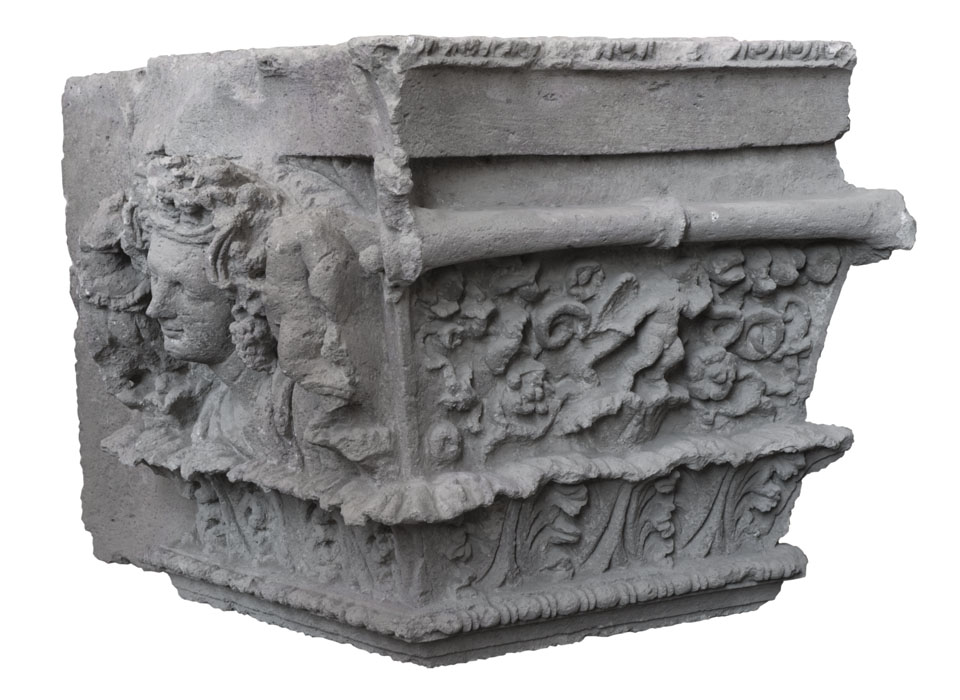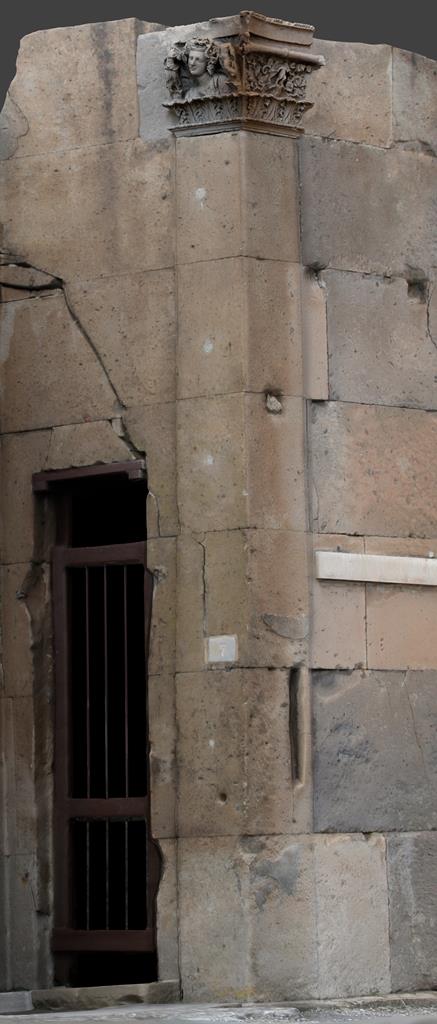Capital
Description
The figured capital retrieved in 1836 from the eastern pilaster of V 1,7 (H. 0.566 m, max. w. 0.67m (street side) - 0.81m (entrance side)) belongs to the group of relief capitals from the so-called tufa period. Several examples have been found in Pompeii, most of them typologised as a "Doppelvolutenkapitell". Our example differs from the others, since it is a combination of a "Doppelvolutenkapitell" and a capital form defined as "Sofakapitell". Apart from its originality concerning the shape, our capital shares the same theme, related to the Dionysian world (For a discussion of these motifs and the choice of subject, see Staub Gierow 1994, 73, Zanker 1998, 37 and most recently, Wyler 2006, 156). In our case, its large front side facing the street was adorned with the depiction of a winged Eros framed by tendrils; the short side towards the Vestibulum holds the bust of Dionysus, framed by two small figures, presumably belonging to the god´s mythological retinue, to the left a female and to the right a male one.
This façade with its figured capital is also an important source of information regarding the question of the dating of the original building phase of the Casa del Torello and its dependencies, mainly through comparisons with similar facades and for the capital, by stylistic means. The period to which the façade belongs, the so-called tufa period, is nowadays generally dated to the time between c. 200 B.C. and the beginning of the last century B.C (Recently confirmed by Adam 2007, 99). The most similar façades from this phase are the one in the Casa del Fauno (VI 12) and the southern facade of the Casa di Arianna (or Capitelli colorati) (VII 4,31.51) (See Hoffmann 1990, 493). The dating of these two façades differs slightly; the first suggestion dated stylistically but also by means of finds from the filling layer related to the original building phase, is generally placed in the beginning of the second quarter of the second century B.C (See Hoffmann 2009, 49f and Faber 2009, 82 - 84), the second one to the end of the third quarter of the same century (See Sear 1994, 55 and Sear 2006, 167 and 172 (The north peristyle from c. 100 - 90 B.C., about 30 years later than the building phase of the southern peristyle, to which the façade in question belongs)).
A precise dating is still missing for the figured capital. The only estimations come from Ronczewski ("...beide gehören dem 3. oder eher noch dem 2. Jh. an.", Ronczewski 1927, 287) and Pernice ("... eines der ältesten und bedeutendsten Tuffkapitelle in Pompeji. " Pernice 1925, 27), confirmed by Mercklin (Mercklin 1962, 71). The figured tufa capital from the Casa dei Capitelli Figurati (VII 4,57) has been analysed in connection with the study of that house and a dating to c.130 - 120 B.C. has been suggested (Staub Gierow 1994, 73). Thus, considering that the pilaster from the Casa del Torello is supposed to be amongst the earliest figured tufa capitals, a plausible date for the façade with its embellishment could be around the middle or the third quarter of the second century, i.e., slightly later than the Casa del Fauno with its supposed model character (Hoffmann 1994, 86: " Tuttavia, per quanto ne sappiamo, è nella Casa del Fauno che il lato esterno principale viene per la prima volta configurata architettonicamente come facciata a pilastri.") and earlier than the Casa dei Capitelli Figurati with its slightly later capital.
Straßenseite: Im Bildfeld, das oben durch den Pulvinus (glatt, in der Mitte durch dreiteiligen Ring gegliedert), an den Seiten durch einen schmale Saum des Volutenbandes begrenzt wird, erscheint in der Mitte, auf zwei kleineren Akanthusblättern stehend, ein geflügelter Eros in Vorderansicht (Kopf fehlt), der mit beiden Händen in das ihn umgebende Rankengeschlinge greift. Die Ranken, in Form runder Stengel, entspringen dem Zweiblattkelch, auf dem der Eros steht, und entwickeln sich nach den Seiten und aufwärts, so daß sie das ganze Bildfeld überspinnen. An ihnen sitzen Blüten und Rosetten verschiedener Form." ....." Eingangsseite: Büste des jugendlichen Dionysos, fast die ganze Breite des Kapitells einnehmend. Der Gott trägt Untergewand und über die linke Schulter geworfenen Mantel; auf der rechten Schulter ist ein Fellstreifen zu erkennen. Im seitwärts gestrichenen Haar mit Mittelscheitel ein Kranz mit Korymben und Trauben, und die backchische Mitre. Vor den Ohren hängen große Trauben herab. Der Kopf ist nach der linken Schulter geneigt. Rechts und links auf kleinen Kelchen stehend und die Volutenansätze verdeckend zwei Gestalten, rechts männlich, links weiblich, beide ohne Köpfe. Rechts ein nackter Knabe (Satyr ?) in Vorderansicht, rechtes Standbein; nur um den herabhängenden linken Arm ist ein Gewand geschlungen, das sich neben dem Oberschenkel bauscht, hinter den Beinen hinzieht und vor den Unterschenkeln nach auswärts geweht wird. Mit der seitlich ausgestreckten Rechten faßt er an das Haar des Mittelkopfes. Sein weibliches Gegenüber (Mänade ?), schräg einwärts gewendet, rechtes Standbein, trägt langen Chiton, der von der linken Schulter herangeglitten ist, mit Überschlag und faßt mit der Linken an das Haar des Dionysoskopfes. Aktion der Rechten nicht ersichtlich. Schräg vor dem Körper Fruchtgirlande. Zwischen den Gestalten und dem Kopf am Grunde je ein großes stehende Akanthusblatt."



